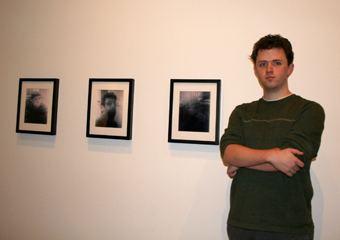Student art exhibit opens at Spertus
Permanent link All PostsStudent artists draw on personal experiences to respond to Spertus exhibit

Becca Willens explores the influence of the Holocaust in her installation.
Becca Willens respects her roots. Growing up in a small Jewish community in Petoskey, Mich. – where hers was one of five Jewish families in town – Willens learned to cherish community from an early age.
Now a senior studying costume design at Columbia College, Willens translated her understanding of community into an installation displayed at Spertus Museum. The piece is a response to Spertus’ “What Does It Say to You?” exhibit.
Willens and five other Jewish student artists from Columbia College and from the School of the Art Institute of Chicago (SAIC) teamed with Hillel’s Arts in the Loop program and Spertus Museum Director Rhoda Rosen to creatively explore “What Does It Say to You?” and construct physical manifestations of their reactions to the pieces in that exhibit.
The students’ pieces are temporarily installed alongside the main exhibition, and Spertus will host a special viewing from 10:30 a.m. to 3 p.m. this Sunday, Dec. 20.
Inspired by a Maryan S. Maryan painting and its color scheme, Willens fashioned a scalloped-edge dress festooned with different-color florettes. The edges of the dress are roots and represent “the Holocaust because our roots were ripped out from under us,” Willens said. The dress also features holes with red tulle peeking out from them – the holes represent the lasting effects of the Holocaust because “some of us still don’t know where we came from exactly,” she said. And the florets – in vibrant blues, greens, and reds are the people. They are scattered at the bottom of the dress and condense at the top, representing the re-emergence of the Jewish people from the shadow of the Holocaust, said Willens, who has served as secretary for the Columbia College’s Hillel for the past two years.
“It’s a very personal piece for me,” she said. “I used materials I had at home for it: antique buttons I used to collect and scraps of fabric from other projects. It forced me to be very selective about what I’m using to fit my theme – growth and unity and how our roots are growing stronger.”
Her contribution is also a memorial to her grandmother, a talented seamstress who passed away while Willens was preparing for the exhibit.

Sam Eisen’s photographs of his brother, father and grandfather bridge his family and his artistic expression.
Other artists also paid tribute to the importance of roots and family through their work. SAIC senior Sam Eisen used his grandparents’ old Super Dollina camera to take photographs of his brother, father and grandfather. The three men read the same Torah portion for their bar mitzvahs, which Eisen saw as “a rite of passage – a father passing the light to his son,” he wrote in his artist statement. Although he usually uses drawing and painting to express himself, Eisen thought it was important to use the camera because it served as “a symbol of my family giving me the means to be an artist,” he wrote.

Jennifer Swann contemplates her grandmother’s favorite phrase in her work.
Jennifer Swann’s contemplation of her Yiddish-speaking grandmother’s favorite phrase, “it’s your America,” led her to respond creatively to seeing a Yiddish typewriter in the Spertus collection. Although she originally wanted to use the typewriter in her installation, she ended up using an English-language machine. She typed out her grandmother’s phrase over and over, copied the sheets and plastered an 8-foot by 15-foot column with the results. Her installation also features a video of her typing out the words.
“[‘It’s your America’] is something my grandma still says that to me all the time, whenever I do something crazy,” said Swann, a junior at SAIC. “I was thinking of ways to materialize that expression because I wanted people to interpret for what it meant to them.”
Also on view was an installation by Max Gutnick, who explored the connection between the physical and the spiritual by building a sensory deprivation room-like experience. He was responding to photocopy transfers by Cheselyn Amato, but wanted to create a structural three-dimensional piece as both a response and a contrast.
“Whenever you analyze yourself or the world, you get glimpses of perfection and different glances at truth, different types of truth, and you are constantly distracted from your contemplation,” said Gutnick, a senior at SAIC, who usually works in visual design. “The idea was that you have to practice to gain a stronger spiritual connection because there’s always going to be distraction in the physical world.”
All the student artists met to discuss their creative process on a weekly basis, contributing to each other’s pieces, brainstorming ideas on materials and evaluating each other’s progress.
“It was definitely a collaborative experience,” Swann said. “For me, I had this loose idea of having this expression, but didn’t know what form it was going to tak,e so just bouncing back ideas and coming into the actual space influenced me.”
Once the student artists’ projects are no longer on view, Spertus’ “What Does It Say to You?” exhibit will continue its interaction with viewers through March 14, 2010. Videos of people’s reactions are on display throughout the gallery, and visitors can leave comments to be read by future viewers.
“‘What Does It Say to You?’ invites viewers to respond without being told by curators what that response should be. It’s about direct engagement with the objects [in the exhibit],” said Rosen, the Museum director.
Hillel and Spertus Institute of Jewish Studies are partners in serving our community, supported by the JUF/Jewish Federation of Metropolitan Chicago. It’s not too late to help fund wonderful organizations like Hillel, Spertus and JUF. Make a donation for 2009 NOW!



.jpg)



